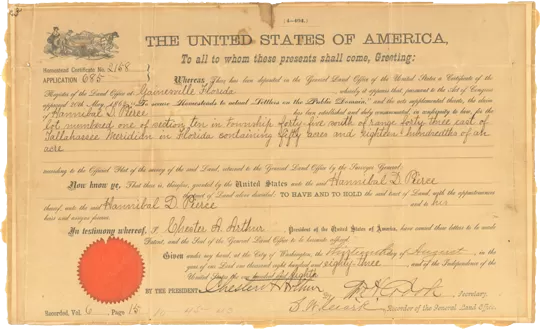



Palm Beach County is a diverse community of people who came from many parts of the United States and the world. Most of the first settlers made their way from the North and the Midwest in the latter part of the 19th century, and for various reasons, from improving their health to seeking adventure. But they all faced the same hardships: a wilderness that was beautiful but daunting, and what pioneer Lillie Pierce Voss described as “millions of mosquitoes to the square inch.” There were few people, no post offices, and no roads to transport goods to northern markets. Once settlers arrived, they were virtually cut off from the rest of the world. With ingenuity and grit, the county’s earliest permanent residents gradually found ways to meet these challenges and connect with the rest of the world.
This place was nothing but a wilderness when we came here in 1876, but how beautiful that wilderness was. When my husband landed from his sailboat, he crawled on his hands and knees through the jungle to find a place to build our house. The people who first settled Palm Beach were not people of means, no means at all, hardly. But they didn’t need money much.
Ella Deer Dimick
The first white settlers in Palm Beach County lived around 22-mile-long Lake Worth, then an enclosed freshwater lake, named for Colonel William Jenkins Worth, who helped to end the Second Seminole War in Florida in 1842. During the pioneer era, the entire area was known as Lake Worth; the town by that name would not exist until 1912.
The first arrivals made their homes on Hypoluxo Island, near the south end of Lake Worth, and on the east side of the lake, now Palm Beach. Although the Palm Beach homesteads stretched from the lake to the ocean, most settlers built not on the oceanfront but on the lake. The middle of the island, and their property, was a swamp full of alligators and mosquitoes. The white settlers laid planks across it to make their way to the ocean, which they used for bathing and fishing. TheSeminole Indians before them did not live on the barrier island, but rather inland.
Laying Claim to the Land: Homesteads
Florida was one of 30 states formed from the “public domain” land that was owned by the federal government and transferred to individuals under Congressional laws such as the Armed Occupation Act of 1842 following the Second Seminole War, and the similar but more successful Homestead Act of 1862.
Generally, the Homestead Act gave any head of family or person over 21 who was a citizen (or intending to become one) 160 acres of land, free of charge, if they built a home on the land, cultivated it, and resided there for five years. Later acts amended the original one; for example, in 1880 it was extended to include both surveyed and unsurveyed land.
Many early settlers purchased their land from the State of Florida, through the Internal Improvement Trust Fund (IITF) created in 1855. The trustees of the IITF managed state land received from the federal government. The “improvements” it arranged eventually included Flagler’s Florida East Coast Railway, the East Coast Canal (Intracoastal Waterway), and drainage of the Everglades. The Internal Improvement Fund still exists as part of Florida’s Department of Environmental Protection.
In 1896 residents along the right-of-way successfully petitioned Dade County to declare the tax-defaulted roadbed a public highway; commissioners appropriated $450 to complete a 20-foot wide road.


